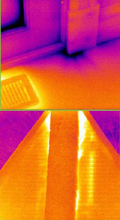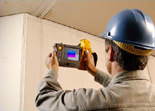
Inspecting to locate air leakage requires a 4°F or higher temperature difference between inside and outside air, in order to get accurate readings. Air leakage can be into the building, as in the cold air shown leaking through the floor, or out of it, as in the warm air leaking out alongside the chimney. (Images courtesy of Snell Infrared ©2005.)
For over 30 years, the U.S. Department of Energy (DOE) has helped low-income families save energy by “weatherizing” their homes. Called Weatherization Assistance, the program is funded by DOE but administered by individual states.
Today’s Weatherization Assistance Programs include a comprehensive series of energy saving measures based on audits of residential units. They take a “whole-house approach” that includes a wide variety of energy efficiency measures and are leading the way in founding a growing industry that makes energy efficient homes available to everyone. Among the tools they use in conducting residential energy audits are handheld thermal imagers.
WHAT TO CHECK?
Blower doors consist of a frame and shroud that fit inside doorframes. Mounted in each blower door is a variable-speed fan that allows it to induce pressure on the inside of a dwelling. Instrumentation that accompanies a blower door includes pressure gauges with which a technician can measure the flow of air through the fan as well as the pressure differential between the living space and the outdoors.With a blower door in operation, a technician armed with a thermal imager and a pressure gauge (to verify the pressure differential in various parts of a dwelling) can find areas that contribute to the loss of conditioned air by convection - heat in the winter and cooling in the summer.
WHAT TO LOOK FOR?
Even before turning on your IR camera, you will have a general idea of the relative “leakiness” of a dwelling. The greater the airflow required to reach a certain pressure differential, the more leaky a living unit is.The most effective thermal imaging work in an energy audit will occur indoors when a living space is being heated or cooled (winter or summer), not in the spring or fall when there is little discernable difference between inside and outside temperatures.

Large gaps are often found around plumbing pipes, recessed light fixtures, chimneys, eve soffits, chaseways, and basement rim joists (where the foundation meets the wood framing). Look carefully at the tops and bottoms of plumbing runs and plumbing vents, especially in attics and basements. Also scan the places where utilities such as electricity and TV cable enter the conditioned-air space. Look for uncharacteristically cold floors in winter, especially floors above garages and crawl spaces. Even if these floors are insulated, the insulation contractor could have left air space between the insulation and the floor allowing the floor to cool by convection.
Heating and cooling losses occur by conduction as well as convection. Conduction losses can happen, for example, at floor slabs that extend outdoors and have no thermal barrier between the indoor and outdoor portions. Conduction can also happen in conjunction with convection when insulation is missing from an outdoor wall.
WHAT SAVINGS ARE POSSIBLE?
Given rising electricity prices, follow-up actions based on the findings of an energy audit are almost certain to save at least 15 percent of the energy a household uses. Figures available on the DOE “Energy Efficiency and Renewable Energy” website illustrate what savings are available from even modest energy-conserving investments.As of 2008, over 6.4 million households had been weatherized by DOE’s Weatherization Assistance Program since its inception. And it is anticipated that over 650,000 homes will be weatherized with American Recovery and Reinvestment Act (ARRA) funding. DOE says weatherization saves $437 in heating and cooling costs year after year at current prices. Energy savings average 35 percent of consumption for the typical low-income home. Similar results can be expected for any housing unit that experiences an audit and appropriate follow-up measures.
FOLLOW-UP ACTIONS
The remedy for energy-wasting leaks is to seal them. Seal plumbing runs and plumbing vents at tops and bottoms. Seal utility access holes and recessed lighting fixtures as required. (Warning: If not done properly, sealing recessed lighting “cans” that are not rated ICAT - insulation-contact-air-tight - will create a fire hazard. Seek expert help.) At a minimum, if you cannot fill suspected air gaps between walls and floors and insulation, seal the ends of the gaps. Also, create thermal barriers where there are conduction losses.Sealing materials for specific applications might vary from aluminum flashing to fiberglass insulation to reflective foil insulation and include standard or high-temperature caulks and expanding spray foam. Whatever the materials required, a 30 percent decrease in energy use can save a homeowner $450 or more per year in energy costs.
Reprinted with permission from the Fluke Application Note “HVAC Air Leakage Inspections.” For more information, visit www.fluke.com.
Publication date:07/05/2010

Report Abusive Comment